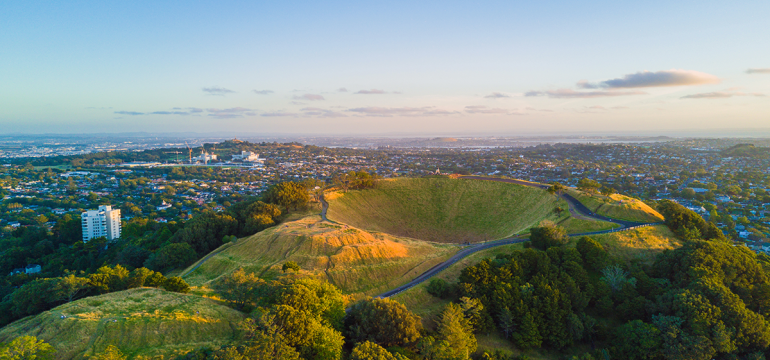Fibre network to help understand earthquakes in Auckland’s volcanic field
Researchers will soon start using Auckland’s fibre network to study smaller earthquakes that could help to detect volcanic activity under the city.
Auckland is built on a volcanic field with 53 recognised volcanoes across the Auckland Volcanic Field, (AVF), posing a substantial natural hazard to New Zealand’s largest city.
Previous eruptions have differed in time and location, making it challenging to predict future events across the AVF.
The 11 GeoNet seismometers currently around Auckland provide good recordings of seismic activity, but the nationwide-focus applied to them does not capture low-magnitude earthquakes, nor the variability that can be used to study the volcanic field.
New Earthquake Commission (EQC)-funded research by Dr Calum Chamberlain and his team from Victoria University of Wellington and the University of Auckland will use fibre-optic technology known as Distributed Acoustic Sensing (DAS) to detect smaller earthquakes of less than magnitude 1.
Victoria University of Wellington and the University of Auckland will use fibre-optic technology known as Distributed Acoustic Sensing (DAS) to detect smaller earthquakes of less than magnitude 1.
“We know there is likely to be an eruption in the AVF sometime in the future and we think that earthquakes might provide some insight into volcanic unrest in the area. Being able to accurately monitor seismic signals is essential to forecast the location and timing of an eruption,” says Dr Chamberlain.
Dr Chamberlain says DAS uses ‘dark strands’ of fibre networks, the sections that are not used by telecommunications, to monitor seismic activity.
Researchers will use laser pulses to repeatedly measure the length of the cables, allowing them to record stretching in the cables due to passing seismic waves. The DAS method allows them to resolve shaking about every 10 metres along the fibre.
Dr Chamberlain says this project will build capability in New Zealand for this important emerging technology, that will provide new ways to detect seismicity wherever communications fibres are installed and says his research will create a catalogue of earthquakes in and around the AVF that traditional methods have not been able to locate and characterise accurately.
“We’re working in collaboration with Australian company FiberSense who have been using this technology to track things like vehicle movements and underground infrastructure issues,” he says.
“FiberSense is excited to be utilising our sensing capabilities in collaboration with Dr Chamberlain’s team to bring greater insights into seismic and volcanic activity. Applying our technology to improve awareness of what’s occurring underground helps play a role in improving community safety,” says Dr Nate Lindsey, Lead Geophysicist for FiberSense.
Dr Chamberlain says: “Using DAS means we can build a picture of seismic activity that will underpin future unrest assessments. The tools we develop will provide high-resolution ways of detecting and monitoring volcanic and seismic hazard in urban environments, not only in Auckland but across New Zealand.”
“Background knowledge of smaller earthquakes will allow us to better understand active faults beneath the AVF and what level of activity is normal, and also possibly identify and map new faults not yet discovered,” Dr Chamberlain adds.
EQC Research Manager Dr Natalie Balfour says that not only will Dr Chamberlain’s work give us a better picture of seismic activity and potential volcanic unrest on the AVF, but the team is developing and testing new tools to measure earthquake activity that many others will be able to use in future.
“With many cities having fibre networks and undersea fibre cables running offshore, the techniques and technology the team is developing will be hugely useful for getting a better picture of seismic hazard in and around Aotearoa New Zealand,” she says.
The project will start in April 2022 and Dr Chamberlain will be working closely with volcanology and seismology experts from Determining Volcanic Risk for Auckland (DEVORA) and will provide the findings to Auckland Council, Tūpuna Maunga Authority and other key stakeholders.
Dr Chamberlain is one of 13 researchers who recently received funding through EQC’s Biennial Grants programme that awards a total of $1m for research into natural hazards and their impacts.
The Biennial Grants programme has been running since 1989 to better understand natural hazard risks and reduce the impact of those hazards for New Zealanders.
